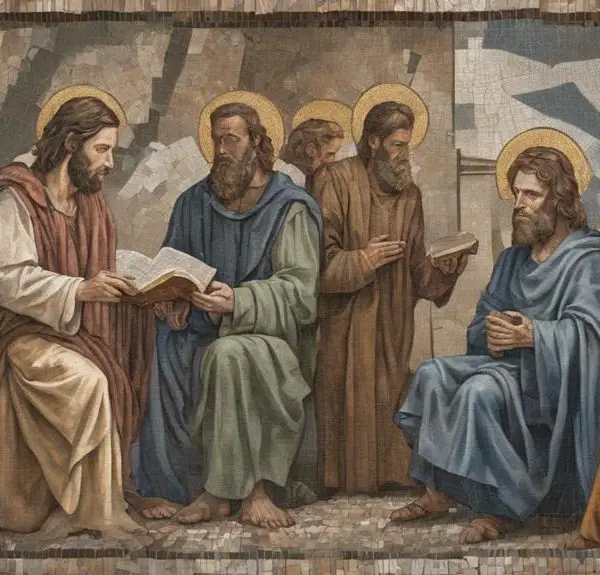Find out the fascinating truths and prophecies in the Book of Amos, the successor to Joel in the Bible's prophetic writings.

Book After Joel in the Bible
Biblical books, brimming with bountiful wisdom, hold histories and prophecies that are just as significant today as they were centuries ago. Have you ever pondered about the book that follows Joel in the Bible?
It's the Book of Amos, an intriguing text filled with powerful messages and prophetic visions. Let's embark on an exploration of this book, as we seek to understand its historical context, interpret its prophecies, and uncover its relevance in our modern world.
Curious about what this journey might unveil?
Key Takeaways
- The book after Joel in the Bible is Amos, known for its strong emphasis on social justice and ethical conduct.
- Amos, a shepherd-turned-prophet, boldly criticized societal injustices and corruption prevalent in his time.
- The book of Amos uses rich, symbolic prophecies like locusts and ripe fruit to convey messages of divine judgement and societal decay.
- Despite being written in the 8th century BC, Amos' messages about equity, integrity, and the importance of justice over rituals remain highly relevant today.
Understanding the Book of Amos

Delving into the Book of Amos, you'll uncover a profound narrative of social justice, divine judgement, and relentless hope. You'll find Amos' authorship unique in the way he captures the socio-religious issues of his time. As a shepherd and a fig tree tender, Amos' literary style is robustly earthy and direct, teeming with imagery from nature and rural life. He doesn't sugarcoat or mince his words, driving his message home with razor-sharp precision.
Analyzing the book, you'll observe Amos' use of repetition and parallelism, a common feature in Hebrew poetry. His bold imagery and metaphors lend a dramatic quality to his prophetic messages. Also noteworthy is his use of a 'vision-report' style, where he describes his divine visions in vivid, graphic detail.
Amos' authorship goes beyond mere documentation. He becomes a voice for the voiceless, challenging the social norms of his era. His literary style, while profoundly simple, is imbued with a raw power that amplifies his call for justice and righteousness. In essence, the Book of Amos isn't just a historical or religious text, but a timeless beacon for social justice and moral responsibility.
Historical Context of Amos

To fully appreciate the depth of Amos' messages, it's essential to understand the historical context in which he wrote. Amos' authorship dates back to the 8th century BC, during a period of substantial prosperity but significant social injustices in both the northern kingdom of Israel and the southern kingdom of Judah.
Yet, beneath this prosperity, you'd find a society riddled with corruption and inequality. The wealthy lived in luxury, while the poor were oppressed and marginalized. Amos, a shepherd and a tender of sycamore fig trees, was profoundly disturbed by these social injustices. His outcry against the societal ills of his time forms the crux of his prophetic messages.
You must note that Amos wasn't a professional prophet; he was a layman called by God to deliver a stern message to Israel and Judah. His prophecies were a courageous denouncement of the rampant corruption, exploitation, and neglect of the poor. Understanding this context helps you appreciate the relevance of Amos' messages today, as they continue to challenge societies grappling with similar issues of inequality and injustice.
Key Messages in Amos

In examining the key messages in Amos, you'll find a recurring theme of social justice, a strong stance against corruption, and a call for repentance. Amos' authorship is attributed to Amos himself, a shepherd and fig tree farmer, who was divinely inspired to become a prophet. His humble background significantly influenced his messages, leading to a profound emphasis on social justice themes.
Amos unflinchingly condemned the rich and powerful who exploited the poor and marginalized. He argued that their wealth and comfort were often gained through dishonest means, leaving the weak and vulnerable to suffer. This critique of social inequality remains a cornerstone of his prophetic messages.
Amos also called for moral integrity, admonishing his audience that ritualistic observance of religious practices is meaningless without ethical living. His message was clear: God desires justice and righteousness more than sacrifices and offerings.
Lastly, Amos urged his listeners to repent and return to a just and compassionate way of life. Despite the harsh realities he outlined, Amos held out hope for those willing to change. His messages serve as a timeless reminder of the importance of social justice, integrity, and repentance in any society.
Interpreting Amos' Prophecies

When it comes to interpreting Amos' prophecies, you must consider the historical and cultural context in which they were delivered. Amos' visions, rife with prophetic symbolism, were not merely abstract predictions of the future. They were tailored for a specific audience, in a specific time, facing specific sociopolitical circumstances.
Prophecy |
Symbolism |
|---|---|
The Locusts |
Israel's socio-political decay |
The Fire |
Divine judgement |
The Plumb Line |
Righteousness standard |
The Ripe Fruit |
Imminent judgement |
You see, Amos utilized familiar imagery to his audience, making his prophecies more relatable and impactful. The locusts and fire, for instance, were symbols of destruction, reflecting the deteriorating morality and impending doom of Israel. Similarly, the plumb line and ripe fruit represented God's standard of righteousness and the inevitability of divine judgement, respectively.
Therefore, in understanding Amos' prophecies, it's crucial to delve into the socio-cultural fabric of that era. Without this context, you're likely to miss the depth of the prophetic symbolism and the messages conveyed therein. Remember, a prophecy isn't just a forecast, it's a divine communication tool, tailored to its recipients.
Relevance of Amos Today

Understanding the relevance of Amos today, you must consider how these ancient prophecies resonate in our modern world. Amos' influence isn't confined to historical or biblical discussions, but extends to modern discourse on social justice and equity. His prophetic challenges against societal corruption, exploitation of the poor, and religious hypocrisy resonate powerfully today.
In a world marked by rampant inequality and systemic injustices, Amos' messages are more relevant than ever. His call for justice and righteousness to 'roll on like a river' (Amos 5:24) is a rallying cry for those advocating for societal transformation. In examining Amos' influence, you can discern a moral compass that navigates the complex terrain of social, political, and religious issues, providing insight and guidance for contemporary application.
The modern application of Amos can be seen in initiatives aimed at addressing social inequalities. His demand for justice and righteousness underpins the principles of many humanitarian organizations and social movements today.
Therefore, you can't overlook the relevance of Amos in today's world. His prophetic voice, echoing from ancient times, still impacts our understanding of justice, righteousness, and societal responsibility, making the book of Amos an enduring source of inspiration and challenge.
Frequently Asked Questions
Who Is the Author of the Book That Follows Joel in the Bible?
You're asking about the author of the book succeeding Joel in the Bible. This book is Amos, traditionally attributed to the prophet Amos himself.
He was a shepherd from Tekoa, with his teachings reflecting his rural background and the cultural influences of his time.
His prophecies, conveying strong social justice messages, are believed to be a direct result of his experiences and the socio-political conditions he observed.
What Is the Chronology of the Bible Books Surrounding Joel?
You're investigating the chronology of Bible books around Joel. Before Joel, you find Hosea and after it, Amos. These books share Joel's prophetic significance.
Your interpretation of Joel's imagery connects it to these surrounding books. It's like a tapestry of prophecy, each book adding to the larger narrative.
This order isn't just historical; it's theological, revealing a divine plan unfolding through the prophets' words and visions.
What Are Some Major Differences Between the Book of Joel and the Book That Follows It?
When comparing the prophetic messages and analyzing Joel's impact, you'll find significant differences between Joel and the following book. Joel often uses apocalyptic imagery, while the next book focuses more on practical advice.
Joel's impact is seen in his call for repentance, whereas the subsequent book provides guidance for daily living. It's a shift from the dramatic to the practical, from prophetic warning to wisdom literature.
How Does the Book After Joel Contribute to the Overall Narrative of the Bible?
Analyzing the prophetic messages and literary style, you'll find the book succeeding Joel significantly impacts the Bible's overall narrative. It complements Joel's message, providing a broader context to God's plans.
Its unique literary style further enriches the biblical text, adding depth and diversity. Therefore, it's crucial to comprehend this book's contribution to fully grasp the Bible's complete narrative.
What Are Some Popular Verses or Passages From the Book That Follows Joel in the Bible?
You're seeking popular verses from a certain book, right? Well, interpretation techniques can greatly affect the impact of these messages.
For instance, Amos 5:24, 'But let justice roll on like a river, righteousness like a never-failing stream!' is a powerful call for social justice.
It's not just about reciting verses, it's about understanding their deep, contextual meanings that contribute to their popularity and influence.
Conclusion
In reflecting on Amos, you've delved into a complex historical context, grasped key messages, and unraveled prophecies. You've seen its enduring relevance today.
As you continue your biblical journey, remember, each book is a unique narrative, a piece of a larger tapestry. Keep questioning, analyzing, and interpreting.
The Bible isn't a static text, but an evolving dialogue between the past and the present, always yielding fresh insights.



Sign up